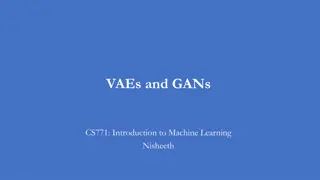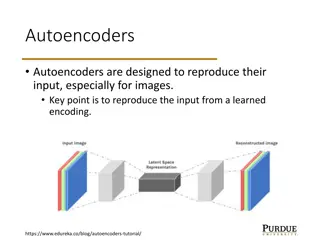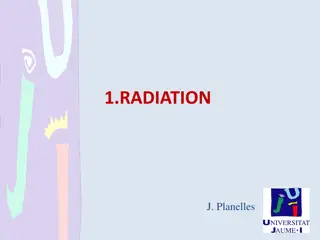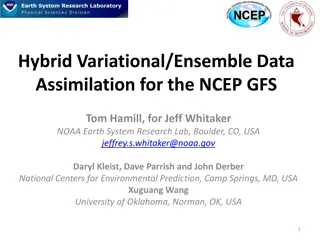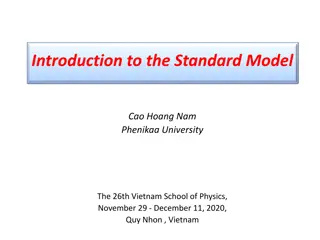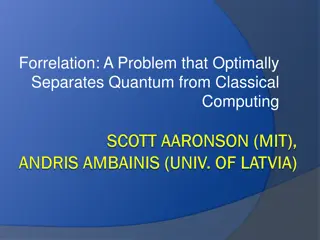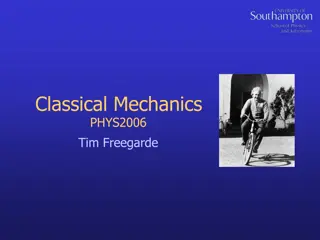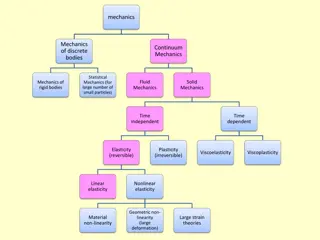Understanding Classical Mechanics: Variational Principle and Applications
Classical Mechanics explores the Variational Principle in the calculus of variations, offering a method to determine maximum values of quantities dependent on functions. This principle, rooted in the wave function, aids in finding parameter values such as expectation values independently of the coordinate system chosen. By delving into configuration space, generalized coordinates, and the calculus of variation, Classical Mechanics uncovers essential concepts crucial for understanding physical systems.
Download Presentation

Please find below an Image/Link to download the presentation.
The content on the website is provided AS IS for your information and personal use only. It may not be sold, licensed, or shared on other websites without obtaining consent from the author. Download presentation by click this link. If you encounter any issues during the download, it is possible that the publisher has removed the file from their server.
E N D
Presentation Transcript
Classical Mechanics B.Sc-Sem-V
Variational principle Chapter-2
Introduction The Variational principle is a principle help in the calculus of variations, it is a general method to find maximum value of quantities which are depend on the functions. This principle is based on the wave function and finding the values of these parameters which is the expectation value. A formulation of mechanics which is independent of the choice of coordinate system Consider quantum system is described by Hamiltonian series with Eigen state with corresponds to Eigen values of energy. H??= ???? (which is Schrodinger equation)
Variational method ?? ? ? ? = ? The above equation is the expected value of H in the state of and it is over estimate for the ground state level energy. If have the excited state , then ? exceed the ??.
Configuration space The parameters that define the configuration of a system is called generalized coordinates and the vector space defined by these coordinates is called the configuration space. the position of a single particle moving in ordinary 3-space. The vector q= (x,y,z) and configuration space is Q = 3. The conventional in Hamilton formulation of classical mechanics and langrangian theorem. The p is indicated as momenta. ?=?? ?? If the particle is in rigid body and free to swing about its origin, it is lie in a space. The configuration space is the subset of coordinates in 3 on the sphere ?2. We can say that the manifold Q id in the space so Q = ?2.
Calculus of variation It is a field of mathematical analysis that uses variations which are small change in function to find minima and maxima. It is the set of function of the real numbers. This function minima or maxima function found by using the Euler-Lagrange equation. We can find the curve of shortest distance by using two points even though the curve is in a space. The maxima or minima are concerned for the calculus of variations and it is also called extrema. A function J ? ?? ? ? ??????? ???????? ??? ??????? ?? ? ? ???????? ???????. J = J[y]-J[f] has the sign for all y in an extreme at function j. And arbitrary function f is called extermal function. The J]f] is called local maximum if J 0
If J 0, function of continuous function ,exrema of corresponding functions are called weak extrema or strong extrema, depending on the first derivatives of the continuous functions.
Technique of the calculus of variation The maxima and minima function are located by finding two points and when we find derivative is zero. This is done by Euler-lagrange s equation, ?2?(x,y(x),y (x)) dx. J[y] = ?1 where ?1?2are constant. y(x) is double differentiable Y (x) = ?? ?? L(x,y(x),y (x)) is double differentiate with the arguments x,y,y . If function J[y] attain local minimum at f and ?(?) is an arbitrary function that has one derivative and become zero at ?1and ?2, then for any number ? close to 0.
J[f] J [ f + ?? ]. The term ?? is variation of the function f and denoted by ??. f+ ?? for y in the functional j[y] and the result is a function ?, ? ? = J ? + ?? . since the function j[y] has minimum for y=f, for the function ? ? has minimum at ?=0 and therefore, ?2?? ? 0 = ?? and y =f + ?? are considered as function of ? rather than x, ?? ?? = total derivative of L [x,y,y ], where y= f + ?? ?? = ?1 ?? ??= ?? ?? ??= ? ??? ?? ??+ ?? ?? ?? ?? ?? ?? ??=?
?? ??= ?? ??? + ?? ?? ? ?2?? ?2 ?? ??? + ?? ?? ? ?? dx = ?1 dx Therefore, ?1 ?2 ?2? ?? ???dx + ?? ?? ? ?1 ? ?? ?? ?? dx = ?1 ?2 ?? ??? ? ? ?? ?? ?? dx = ?1 where L[x,y,y ]- L[x,f,f ] where ?=0. The second derivative is zero, ? =0 ?2? ? ?? ?? ? ?? ?? ?? dx =0 which is Euler-lagrange equation. ?1
The delta notation In the calculus of variation may vary with the functions and it is denoted by ?- delta notation. ?2 ?? ?? ??= ?1 ? ?? ?? ?? ?? ??dx ?? Multiplying both sides with dx, ?2 ?? ?? ??dx = ?1 ? ?? ?? ?? ?? ??dx.dx ?? ?? ??dx = ?J ?? ??dx = ?y ?2? ?,? ,? dx = 0 So we have, ?J = ? ?1
Take ? in the integral sign, ?2???? ?J= ?1 ?2 ?? ?? ?? ?? dx = ?1 ???? + ?? ??= ? Now, dy =? ???? Integrate the equation on right hand side we will get, ?2 ?? ? ?? ?? ?? ?J = ?1 The variation of y at the end point is zero. If dy is arbitrary than ?J =0 and this is same as Euler-lagrange s equation. ?y dx ??
Application of the variable principle 1. Consider extreme value of integer, ?2? ?,? ,? dx J = ?1 2 ?? ?? where ? = and ? ? = ? ? ?,? = ? + ?? ? Where ? ? = ? ?1 ? ?2 and satisfied boundary condition, ? ?1 =? ?2=0 ?? ??=1 ? ?1+ ?2+2?? 1 ?? 2?? , where ?=?1+?2
Square and substitute the value, than we get ? = 0,? = ?2 ?1 and the value of ? ? > ? 0 for any value of . ?? ??=0 for ? = 0 . 2. Euler s Lagrange's equation becomes, ? ?? ?? ?? = 0, ?? 1 2?by assumption. ?? = constant= ? 2 ? 1+? 2=1 2? ? ? = 2? ? ? Now integrate, y= 2? ?dx ? = ? 1 cos? ? y= ? 1 cos? ?? = ? 1 sin? + ?????.
The constant term=0, when x=y=0 and ? = 0 So equation is ? = ? 1 cos? y = ? ? sin? This equation is cycloid equation passing from the two points and found to be minimum for the Variational principle is extreme. These are the two possibilities which are applicable on Variational principle.
References: 1.R.G.Takwalw , classical mechanics book 2.Slideshare.net 3.Wikipedia.org 4. Lecture notes of Raz Kupferman,Institute of Mathematics,The Hebrew University By- Tejas Pandya, Assistant professor, Neotech Institute of Applied Science & Research, at. Virod, vadodara Thank you







